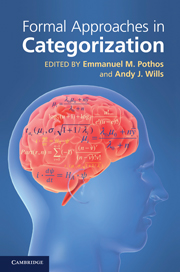Book contents
- Frontmatter
- Contents
- List of figures
- List of tables
- List of contributors
- 1 Introduction
- 2 The generalized context model: an exemplar model of classification
- 3 Prototype models of categorization: basic formulation, predictions, and limitations
- 4 COVIS
- 5 Semantics without categorization
- 6 Models of attentional learning
- 7 An elemental model of associative learning and memory
- 8 Nonparametric Bayesian models of categorization
- 9 The simplicity model of unsupervised categorization
- 10 Adaptive clustering models of categorization
- 11 Cobweb Models of Categorization and Probabilistic Concept Formation
- 12 The knowledge and resonance (KRES) model of category learning
- 13 The contribution (and drawbacks) of models to the study of concepts
- 14 Formal models of categorization: insights from cognitive neuroscience
- 15 Comments on models and categorization theories: the razor's edge
- Index
- References
13 - The contribution (and drawbacks) of models to the study of concepts
Published online by Cambridge University Press: 05 June 2012
- Frontmatter
- Contents
- List of figures
- List of tables
- List of contributors
- 1 Introduction
- 2 The generalized context model: an exemplar model of classification
- 3 Prototype models of categorization: basic formulation, predictions, and limitations
- 4 COVIS
- 5 Semantics without categorization
- 6 Models of attentional learning
- 7 An elemental model of associative learning and memory
- 8 Nonparametric Bayesian models of categorization
- 9 The simplicity model of unsupervised categorization
- 10 Adaptive clustering models of categorization
- 11 Cobweb Models of Categorization and Probabilistic Concept Formation
- 12 The knowledge and resonance (KRES) model of category learning
- 13 The contribution (and drawbacks) of models to the study of concepts
- 14 Formal models of categorization: insights from cognitive neuroscience
- 15 Comments on models and categorization theories: the razor's edge
- Index
- References
Summary
A book that focuses on computational models carries with it the presupposition that modelling is an important and useful activity. And so it is. But why? What does modelling add that other kinds of theorizing or empirical work do not? And what can go wrong in modelling? In this chapter, I will take a step back to address these questions. I cannot hope to teach much to experienced researchers in this field, but I think that for students, newcomers, and sceptics, it is useful to consider what modelling adds and how it can sometimes detract from the enterprise of doing cognitive psychology. On the whole, I think that the contribution of computational models has been positive to our understanding of concepts. But at the same time, I think that some of the persisting shortcomings in the field of concepts are in part due to an emphasis on modelling or to the way researchers use models as a tool to enhance our understanding of concepts.
We can learn about concepts by doing category-learning experiments, by making cross-cultural comparisons, by carrying out observational studies, and by studying the properties of natural categories, among other techniques. Each of these will tell us some things but cannot tell us other things. So it is with building models of concepts. A chapter such as this one might focus more on problems than on benefits, but it should be understood that there are pitfalls and limitations in every method.
- Type
- Chapter
- Information
- Formal Approaches in Categorization , pp. 299 - 312Publisher: Cambridge University PressPrint publication year: 2011
References
- 4
- Cited by



